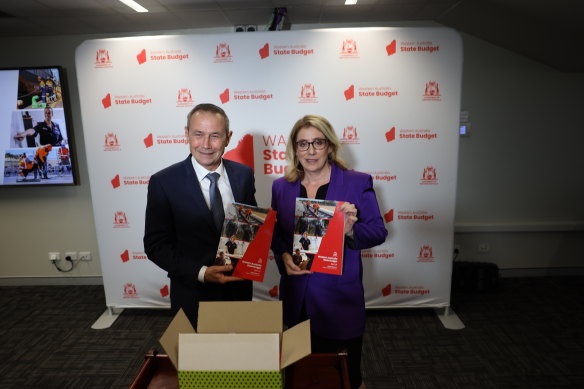Opinion
WA is finding it hard to admit it has a spending problem
Hamish Hastie
ReporterWestern Australia’s iron ore curtain is obscuring some fiscal sins buried in Thursday’s state budget.
The state has a huge spending addiction and like all addicts – it keeps up its habit while lying to itself that it will kick it at a later date.

West Australian Premier Roger Cook and Treasurer Rita Saffioti with the budget papers in Perth on Thursday.Credit: Hamish Hastie
Rita Saffioti’s first budget as Treasurer showed total government expenses grew a whopping $3.4 billion over the year to $41.9 billion.
That is an increase of 9 per cent. It isn’t the state’s biggest-ever jump in expenses, but it is comparatively large and it comes on top of an 8 per cent jump the year before.
What is galling about this is the Cook’s government’s projections for the next four years.
It thinks it can slow expenses growth to 4 per cent in 2024-25 and reverse it by -4.4 per cent in 2025-26.
Fat chance of that happening if you listened to Premier Roger Cook yesterday talking about big-budget areas like housing and health.
“This budget doubles-down on our work to accelerate housing, we will invest like never before in quality healthcare ... our infrastructure program shifts up another gear this budget,” he said.
If you flick back to the 2022-23 budget you’ll see a similarly optimistic outlook on spending.
Back then the government estimated spending would increase that year by a dainty 1.7 per cent to $36.8 billion.
It also predicted by the financial year we’re currently in, expenses would have dropped 4.9 per cent before stabilising at 1.8 per cent in 2024-25.
The aforementioned 8 and 9 per cent jumps that actually happened in those years prove the current forecasts are totally fanciful.
Expense growth in WA hasn’t really been scrutinised like it has in the east because iron ore royalty revenue has wildly exceeded forecasts in every budget and mid-year review since COVID.
This year the revenue generated from iron ore alone hit $9.8 billion.
It is an enviable annual pot of money the Cook government has used to pay for both its ambitious $42 billion infrastructure program and increased operating expenses – and boy are they increasing.
This time around the state has added another $391 million to the education budget just to deal with higher student enrolments and $1.2 billion for “increased hospital activity.”
This isn’t bad financial management – most of WA’s increased spend is demand-driven thanks to roaring population growth (a net increase of 94,000 people last year) placing pressure on housing, education and health budgets.
It is necessary spending that would have serious social and political repercussions if it wasn’t done.
But it makes the Labor government’s austerity stance in its first two years of office – like the Sustainable Health Review that was meant to reign in out of control health spending – seem like it occurred in another universe.
No one bats an eyelid if the bills are being paid, but such unwieldy spending puts the state in a precarious situation if the iron ore party ends abruptly.
Thanks to a depressed property market and increased global iron ore competition the budget papers aren’t as buoyant about our biggest customer China as they used to be.
If the money dries up, WA will have to kick its spending habit quickly, but the cold turkey approach will be tough to swallow.